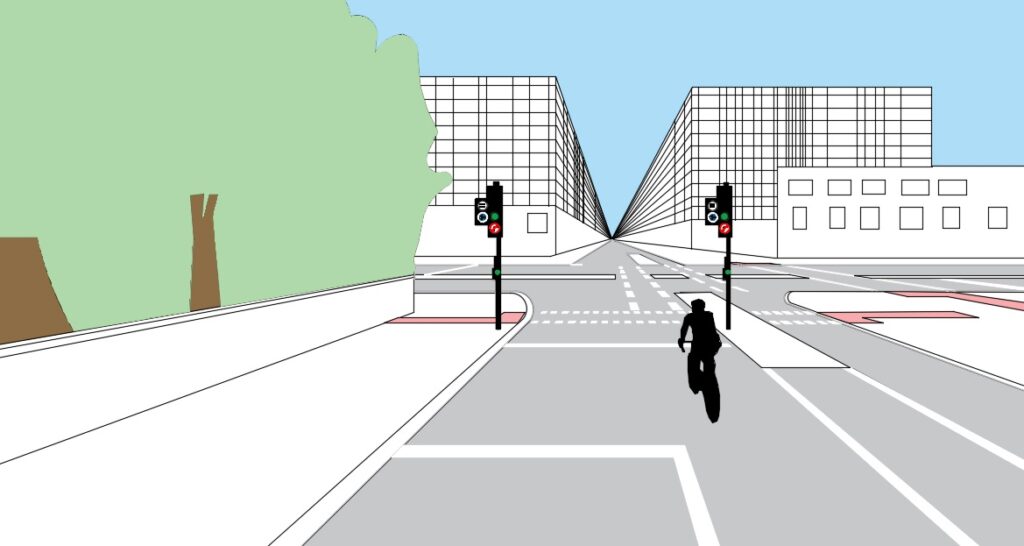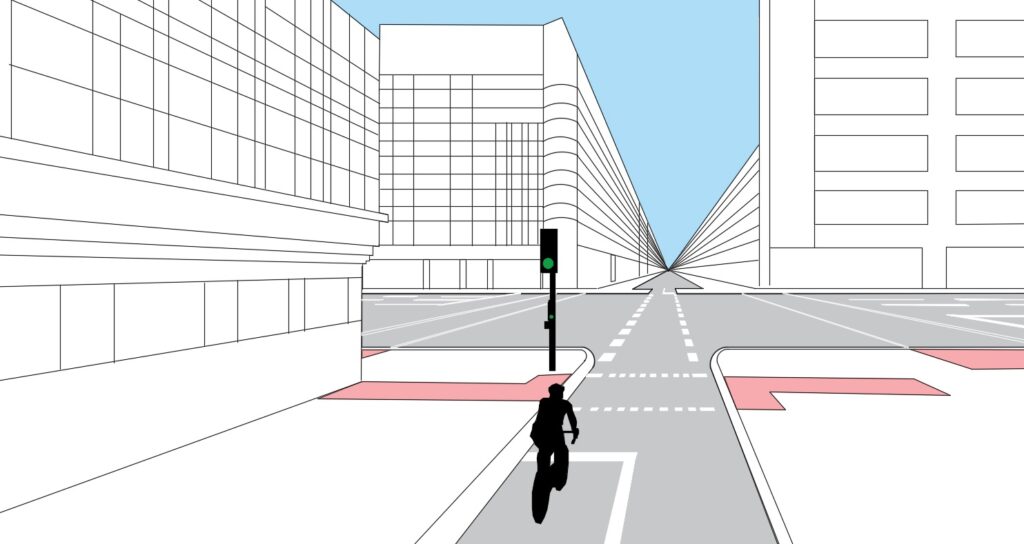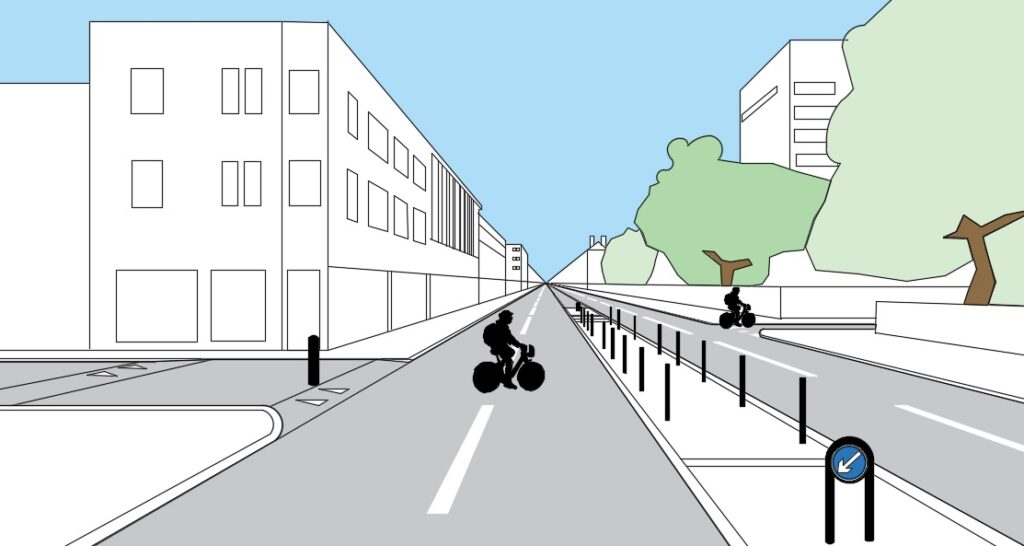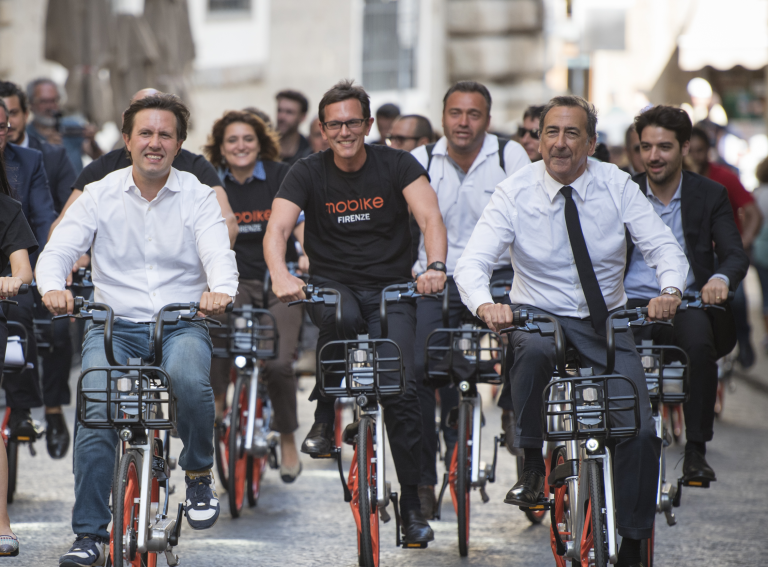What’s cheap, and incredibly good for boosting cycling and walking trips, but has no name?
We tend to not be very good at doing junctions, or crossings, for cycling in the UK. Often we end up with a bike lane that keels over at a junction, disappearing suddenly as if to say, “you’re on your own now, pal!” Sometimes there’s END painted on the road, as if to underline the point, or people on bikes are lumped into a crossing with pedestrians, which is bad for everyone involved. Sometimes they’re left to sit in the middle of a busy road waiting for a gap in traffic. Otherwise half-decent cycling routes are too often ruined by a lack of imagination when it comes to crossing busy roads.
(NB: When we talk about the needs of cyclists here, the lessons apply equally to other forms of micromobility, such as e-scooters, cargo bikes and even mobility scooters. Really, we should start referring any space that isn’t the pavement or the carriageway reserved for cars as “micromobility infrastructure”, because there are all sorts of devices that ought to be better accommodated. But that’s a different discussion so we’ll stick with cycling here.)
To say there’s a better way is perhaps obvious, but we often don’t know about them, because decent cycling crossings are pretty rare and, frankly, don’t have a catchy name.
Less-cute names include “parallel signalized crossings” or “gateways”, but one of their biggest cheerleaders likes to call the good ones “cheeky crossings”, because they do so much for so little.
Whatever the name (“elephant crossing”, after the ‘elephant’s footprints’ markings often involved, or “Chris Crossing”, after Chris Boardman or the ’90s hip-hop duo?), at their most basic we’re talking about variations on a junction with a cycling-only arm. Think of a crossroads and replace one arm with a cycle route – which could be a dedicated cycle track on a busy road, or a filtered residential street restricting or preventing through traffic other than cycles (or even a one-way street).
The beauty of these simple interventions is they help people safely cycle across busy main roads, stress-free – hatching a fledgling cycle network.
“For me these are the best things in the whole country for cycling,” Brian Deegan, a street design engineer behind many of London’s cheeky crossings over the last three decades, tells me over Skype. “They are cycling’s best kept secret. We need a funky name for them.”
Either way, these are how you link low-traffic neighbourhoods (LTN) across main roads. Deegan says every LTN needs one on each side.
“It’s a signal-controlled junction, but it’s clearly a crossing, but it’s not.” When is a crossing not a crossing, you ask? When cycles are separated from pedestrians, and treated like traffic.
Mark Philpotts (aka Ranty Highwayman), a walking and cycling design specialist, says the Netherlands took its first steps towards its now legendary cycle network using these simple tools.
“If you look at old photos of the Netherlands, parts of 1970s Amsterdam look like the UK today,” he says – and the network was built up from there. While the Dutch are on their fourth generation of improvements, they started off tackling crossings.
Philpotts says: “If you’re starting from a low cycling base, it’s a way of giving people the opportunity to travel around their local area by bike. It’s a way of linking low-traffic neighbourhoods. Eventually you have to tackle the main roads but if you’re trying to get kids to school or people to the shops, it’s a really good start.”
He points out 80% of Dutch streets don’t have infrastructure, because they’re just quiet streets, using tools like “cheeky junctions”.
“Crossings, if you use them as part of the filter, maybe people see a bit more of a point to it,” than a simple filter, he says. “We’re not doing it just to make the place quiet, we’re doing it to make it walking and cycling safer.”
Our current default crossing isn’t good enough, to Deegan’s mind. Toucans, he says, are “terrible” for cycling, far too slow and awkward to manoeuvre, and “no-one should be doing them”, while parallel zebra crossings are only suitable for streets with less than 8,000 vehicle movements per day. Both too often involve shared use with pedestrians, something the government says it will no longer fund. Evidence shows shared use paths are so inconvenient they can actually depress cycling levels.
To see one in action, here’s Hackney man Brian Jones cycling one of the newest and possibly best ones, beside St Pancras Station in central London:
I do enjoy cycling across Euston Road from this cycles only section of Judd Street and into Midland road on the stepped cycle tracks separated from motor traffic past St Pancras Station.
— filter more streets (@iambrianjones) September 29, 2020
Thanks for this #spaceforcycling pic.twitter.com/ATfOkl2z5y
Because they’re often parallel with pedestrian crossings they don’t take time out from motor traffic, (like the ingenious ‘cyclops’ junctions Deegan is overseeing in Manchester), making them less scary for officials to sign off.
Deegan has named the three main types: “Go Your Own Way”, “Downface Dog” and “Double Filter” (see pictures). The first holds traffic at red, or bans a traffic turn, while cycles are moving, to prevent vehicles turning across cyclists’ paths. Downface Dog is a protected area in the middle of a main road, for dogleg crossroads, and a Double Filter is where streets either side of a junction are ‘filtered’ to permit only cycles, or cycles and one-way traffic.
They make “what would be horrific barriers to cycling – ‘how the hell would you get across that crossing’ situations, where you have to get off the bike, wiggle over a pedestrian crossing, or wait for the green light, where there’s conflict – easy.”
Although the first known drawings of these junctions in the UK date back to the mid-70s, when the Dutch were building theirs, our first cheeky junctions didn’t materialise until 1984 in London. They remained a cheap option for improving cycling in the capital in the intervening years. While we didn’t go all-out on them, in many ways the few that did appear have since quietly opened up swathes of London to cycling. Thanks to them, “you can ride from Camden Town to Waterloo Bridge and not see any cars.”*
If done in larger numbers, Deegan believes they “could open up the whole of London – even in reluctant boroughs, because it’s just filters and pedestrian crossings,” and once the filters are in, “job done.”
This could also apply nationwide, to the government’s big cycling vision, Gear Change, which includes thousands of miles of new cycle routes.
“I don’t see how we can make gear change objective of always segregating and never sharing [with pedestrians] without these,” says Deegan.
“The best thing for cycling has been hiding in plain sight for too long.”
Manchester’s Bee Network cycling and walking programme is, at its heart, a massive junctions and crossings programme – 500 of them coming to the city in the coming years. The city’s first cheeky junction (which is actually a crossing) will appear next week in Gillbent Road, in Stockport near a school, and another “imminently”, in Harpurhey.
“They shouldn’t be as accidentally weird as they are, they should be mainstream,” says Deegan. “I won’t accept anything else in Manchester”.
Where are they?
Deegan says “truly cheeky junctions” have maximum impact on cycling with a small budget, relying on banned turns or avoiding signals altogether and using road markings.
Ultimately this is a celebration of design ingenuity – cunningly tackling roads that historically prioritised motor traffic, by making space for those cycling and walking with minimal intervention.
Here are a few of the best.
Mare Street by St Thomas Square, Hackney. Downface Dog. Cheekiness rating: 8/10
Gets you across four lanes of traffic without any signals, and without leaving you exposed in the middle of the road – thanks to a wand protected island in the middle. Good for crossing on foot and by bike.
Euston Road / Judd Street, Central London. Single filter to cycle track. Cheekiness rating: 10/10
“Simply one of the best crossings in the world,” says Deegan. “I wish it were one of mine. This safely connects Camden with Bloomsbury using a single filter on Judd Street, and cycle tracks on Midland Road. “What makes it amazing is the sheer distance you travel separated in time from any conflict [with other road users],” crossing six lanes of traffic on Euston Road in a ‘safe haven’ between traffic phases, parallel with pedestrians so it doesn’t hold up motor vehicles. Northbound there’s another cheeky junction just half a mile later, at the bottom of Royal College Street.
Ruckholt Road, Waltham Forest. Go Your Own Way. Cheekiness rating: 9/10
Not strictly in our definition of ‘cheeky junctions’ but worth including because of what it achieves with one traffic light. This is a dedicated cycle traffic light phase onto a ‘missing’ section of otherwise protected cycle route, where the road narrows to a lane in each direction, leaving 100m or so with no cycle tracks. Thanks to these lights, cars are held back until you return to the protected lane. “One of my better ideas,” says Deegan.
Colebrooke Row, Islington. Triple filter. Cheekiness rating: 7/10
“There is a reason Boris [Johnson] used to cycle to work [in City Hall as London Mayor] every day and that is because he lived next to this beauty,” says Deegan. “It gets you across the nightmare that is the Angel Gyratory in style – and with a smile.”
This is a filter, onto a two-way cycle track in the middle of a gyratory, to another filter – and then, actually another if you’re headed West to Myddleton Square.
“At one stage it looked like everyone in North East London was heading for this crossing. The central section where you can stop, sit down have a sandwich and then finish crossing is nice too.”
Stanhope Place to the North side of Hyde Park. Go Your Own Way to separated path. Cheekiness rating: 4/10
Until recently this was “the best way into Hyde Park” from the North (before a fancy new cycleway appeared to its West). Southbound into Hyde Park from Stanhope, drivers go left only, leaving safe space for the signalized cycle crossing to the right of the traffic lane, parallel with pedestrians. “Totally efficient, no delay for anyone. It has inspired me for years,” says Deegan.
Carlton Vale. Parallel crossing. Cheekiness rating: 9/10
This, Deegan says, is one of his masterpieces, that “lets cyclists ride the wrong way around a gyratory without signals or shared use, using only the power of parallel crossings.”
From the junction’s Eastern side, the cycle lane joins the pavement, and crosses a busy gyratory road on a parallel crossing with pedestrians. From there it follows a painted arc across a pedestrian island to a second parallel crossing and on to a protected cycle track, letting cyclists go the ‘wrong way’ up the gyratory – with wands buffering them from oncoming traffic.
Says Deegan: “Remember me thus.”
* From Camden Town at the top of Royal College Street, a protected cycle lane that’s also Deegan’s work, you encounter your first cheeky junction at Royal College’s South End, another one just over half a mile later, crossing the notorious Euston Road to Judd Street, by St Pancras International Station. Then it’s 1.5 miles to Holborn, Newton Street/New Oxford St, and another two to the final filter at Wellington Street, before the dual carriageway of Waterloo Bridge. You will probably see some cars en-route but it’s not bad work for just four junction treatments and some traffic lights.







